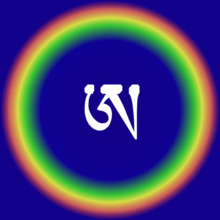Rigpa

| Part of a series on |
| Tibetan Buddhism |
|---|
 |
|
Practices and attainment |
|
History and overview |
|
In Dzogchen teaching, rigpa (Tibetan: རིག་པ་, Wylie: rig pa ; Skt. vidyā; "knowledge") is the knowledge of the ground.[note 1] The opposite of rigpa is marigpa (avidyā, ignorance).
Definition
Rigpa is the knowledge of the ground.[note 2] Erik Pema Kunsang translates a text which provides basic definitions of rigpa and marigpa in a Dzogchen context:
Unknowing (marigpa) is not knowing the nature of mind. Knowing (rigpa) is the knowing of the original wakefulness that is personal experience.[3]
In Dzogchen, a fundamental point of practice is to distinguish rigpa from sems (citta, (grasping) mind).[4]
Kadag and lhungrub
Rigpa has two aspects, namely kadag and lhun grub.[5] Kadag means "purity" or specifically "primordial purity".[6][7] Lhun grub in Tibetan normally implies automatic, self-caused or spontaneous actions or processes.[8] As quality of rigpa it means "spontaneous presence"[6][note 3] It may also mean "having a self-contained origin", being primordially Existent, without an origin, self-existent.[8] This division is the Dzogchen-equivalent of the more common Mahayana wisdom and compassion division.[5]
Full measure of rigpa
Citing Dodrupchen Jikme Tenpe Nyima, the 14th Dalai Lama states the full measure of rigpa occurs with the third vision.[9]
Practice
Dzogchen practices aim to attain rigpa and integrate this into everyday life:
The practical training of the Dzogchen path is traditionally, and most simply, described in terms of View, Meditation and Action. To see directly the Absolute state, the Ground of our being is the View; the way of stabilising that view, and making it an unbroken experience is Meditation; and integrating the View into our entire reality, and life, is what is meant by Action.[10]
The Menngagde or 'Instruction Class' of Dzogchen teachings are divided into two parts: Trekchö and Tögal (thod rgal). Ron Garry:
The practice is that of Cutting through Solidity (khregs chod), which is related to primordial purity (ka dag); and Direct Vision of Reality (thod rgal), which is related to spontaneous presence (Ihun grub).[11]
See also
Notes
References
Citations
- ↑ Norbu 2002, p. 56.
- 1 2 Schaik 2004, p. 5.
- ↑ Kunsang 2006, p. Chapter 15.
- ↑ Kunsang 2012, p. 154.
- 1 2 Dalai Lama 2004, p. 32.
- 1 2 Rinpoche Dzogchen Ponlop 2003.
- ↑ Dalai Lama 2004, p. 30.
- 1 2 Hookham 1991, p. 49-50.
- ↑ Dalai Lama 2004, p. 183-4.
- ↑ Sogyal Rinpoche (1992), The Tibetan Book of Living and Dying, p.151]
- ↑ Dudjom Rinpoche. Wisdom Nectar. Snow Lion 2005, page 296.
Sources
- Published sources
- Batchelor, Stephen (2010), Confession of a Buddhist Atheist, Random House LLC
- Chökyi Nyima Rinpoche (1994), Union of Mahamudra and Dzogchen, Rangjung Yeshe Publications
- Chökyi Nyima Rinpoche (2004), The Bardo Guidebook, Rangjung Yeshe Publications
- Dalai Lama (2004), Dzogchen. Heart Essence of the Great Perfection, Snow Lion Publications, ISBN 978-1-55939-219-8
- Garfield, Jay L.; Edelglass, William (2011), The Oxford Handbook of World Philosophy, Oxford University Press
- Hookham, S.K. (1991), The Buddha Within: Tathagatagarbha Doctrine According to the Shentong Interpretation of the Ratnagotravibhaga, SUNY Press
- Karma Chagme; Gyatrul Rinpoche; Wallace, B. Alan (1998), A Spacious Path to Freedom: Practical Instructions on the Union of Mahamudra and Atiyoga, Snow Lion Publications
- Khenchen Trangu Rinpoche (1998), The Practice of the Tranquility and Insight: A Guide to Tibetan Buddhist Mediation, Snow Lion Publications
- Kunsang, Erik Pema (2006), Quintessential Dzogchen, Ranjung Yeshe
- Kunsang, Erik Pema (2012), Perfect Clarity, Ranjung Yeshe
- Newman, Bruce (2004), A Beginner's Guide to Tibetan Buddhism, Snow Lion Publications
- Norbu, Namkhai (2002), Dream Yoga Revised, Snow Lion
- Pettit, John Whitney (1999), Mipham's Beacon of Certainty: Illuminating the View of Dzogchen, the Great Perfection, Wisdom Publications, ISBN 0-86171-157-2
- Ray, Reginald (2001), Secret of the Vajra World, Shambhala
- Rinpoche Dzogchen Ponlop (2003), Wild Awakening: The Heart of Mahamudra and Dzogchen, Shambhala Publications
- Schaik, Sam (2004), Approaching the Great Perfection: Simultaneous and Gradual Methods of Dzogchen Practice in the Longchen Nyingtig (PDF), Wisdom Publications Inc.
- Schmidt, Marcia Binder (Ed.) (2002), The Dzogchen Primer: Embracing The Spiritual Path According To The Great Perfection, Shambhala Publications, Inc., ISBN 1-57062-829-7
- Tenzin Wangyal Rinpoche (2000), Wonders of the Natural Mind: The Essence of Dzogchen in the Native Bon Tradition of Tibet, Snow Lion Publications
- Tenzin Wangyal Rinpoche (2001), Het wonder van onze oorspronkelijke geest. Dzokchen in de bontraditie van Tibet (Dutch translation of "Wonders of the Natural Mind"), Elmar BV
Further reading
- Schmidt, Marcia Binder (Ed.) (2002), The Dzogchen Primer: Embracing The Spiritual Path According To The Great Perfection, Shambhala Publications, Inc., ISBN 1-57062-829-7
- Guenther, Herbert V. (1992). Meditation Differently: Phenomenological Psychological Aspects of Tibetan Buddhist (Mahamudra and Snying-Thig Practices from Original Tibetan Sources). Delhi: Motilal Banarsidass Publishers (repr. 2005). ISBN 81-208-0870-3 (hardbound).
- Surya Das (2007). Natural Radiance: Awakening to Your Great Perfection. Sounds True. ISBN 1-59179-612-1
External links
- Terms
- Texts
- Shabkar Lama (author), Keith Dowman (translator), The Flight of the Garuda
- Hitting the Essence in Three Words